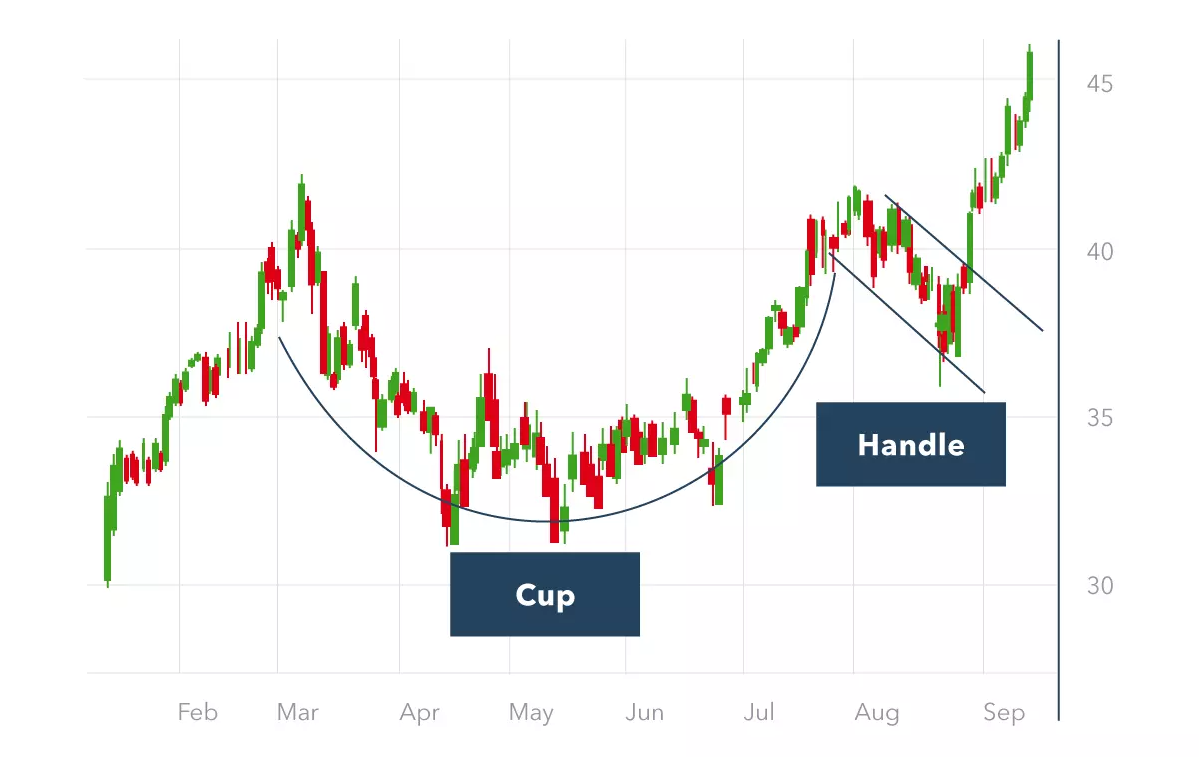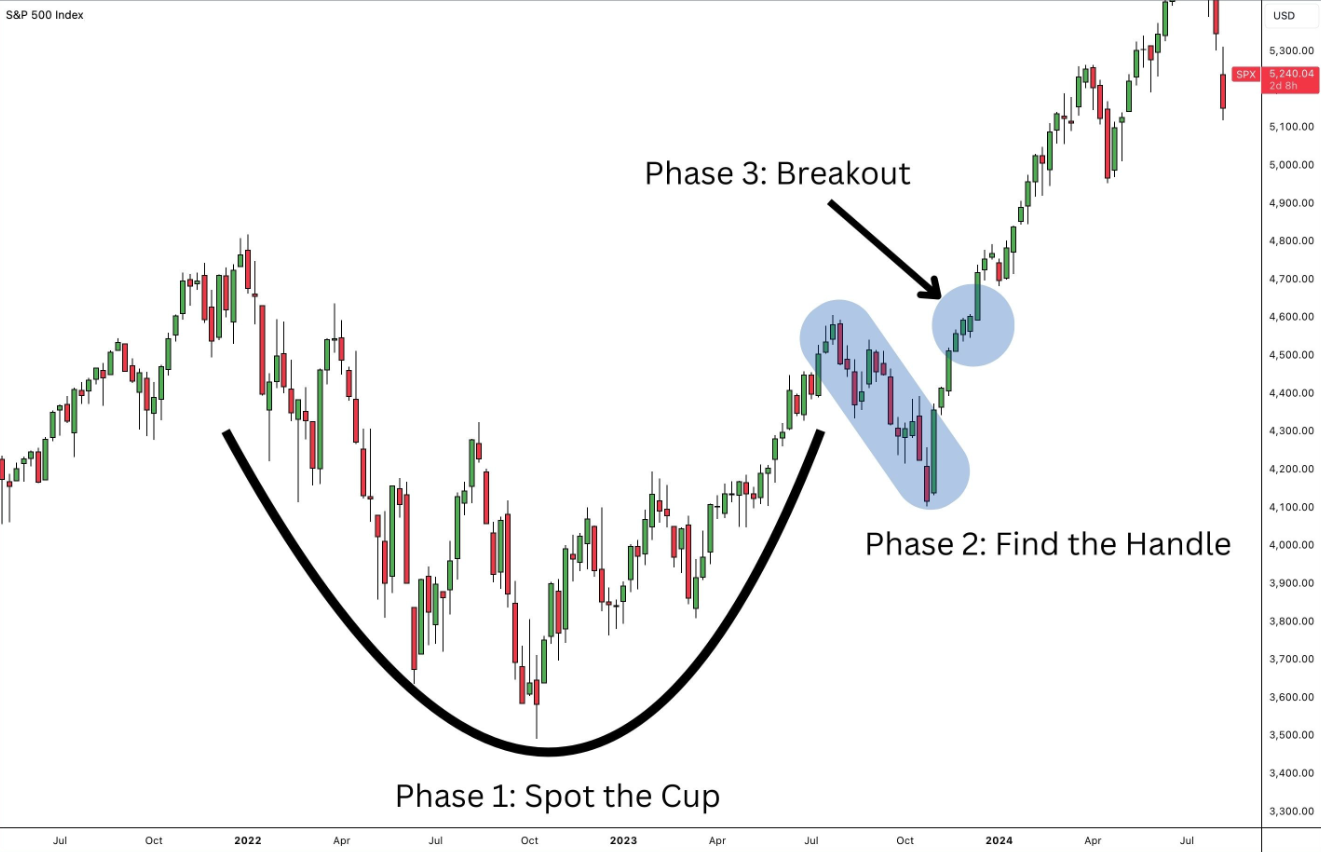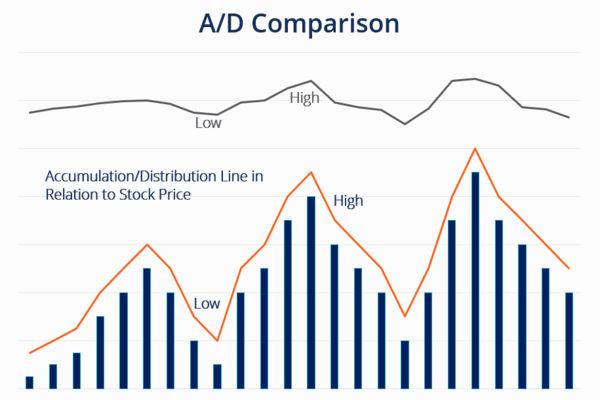The cup and handle pattern is a widely recognised chart formation traders use to identify potential bullish continuation setups. Initially popularised in the stock market, this pattern has proven to be as effective in forex trading.
First introduced by William J. O’Neil, the formation consists of two distinct parts: a rounded bottom resembling a cup and a smaller downward consolidation known as the handle. Typically, this pattern indicates a temporary pause before an asset resumes its upward trend.
Understanding the Cup and Handle Pattern

The Cup and Handle pattern consists of two main components: the cup, which forms a rounded bottom resembling a bowl, and the handle, which appears as a smaller consolidation phase before the breakout. The cup portion reflects a gradual decline followed by a recovery, creating a U-shaped structure.
This indicates that the market has undergone a correction, found strong support, and is now regaining its upward momentum. The handle forms after the cup as the price moves sideways or slightly downward in a tight range before breaking out to the upside.
The psychology behind this pattern is straightforward. During the cup formation, sellers drive prices lower, but buyers gradually step in, leading to a steady recovery. Once the price returns to its previous highs, some traders take profits, causing a minor pullback that forms the handle. This temporary consolidation helps remove weaker hands from the market, allowing strong buying momentum to push the price higher once the breakout occurs.
In forex trading, the Cup and Handle pattern often appears on larger timeframes, such as the four-hour, daily, or weekly charts, making it an excellent tool for swing traders and long-term investors. However, it can also form on lower timeframes, offering opportunities for day traders looking for short-term breakouts.
Identifying a Strong Cup and Handle Setup in Forex

Spotting the cup and handle pattern in forex requires careful price action observation over time. The formation typically develops over days, weeks, or even months, depending on the time frame analysed. Traders first look for a rounded bottom, which signifies a gradual shift in momentum from bearish to bullish.
For example, a well-defined cup and handle should have a smooth, rounded cup formation rather than a sharp V-shape. The depth of the cup is a crucial factor, as excessively deep cups may indicate a lack of stability, while shallow cups suggest weaker momentum. Ideally, the cup should retrace between 30% and 50% of the preceding uptrend before beginning its recovery.
Moreover, the handle should form near the resistance level of the cup, creating a small downward or sideways consolidation before the breakout. A strong handle typically lasts a few days to a few weeks, depending on the timeframe, and should not drop more than 15% to 20% from the cup’s peak. If the handle extends too far downward, it may signal a weakening trend and invalidate the pattern.
Volume is a key confirmation factor when trading the pattern. During the formation of the cup, volume often declines, indicating reduced selling pressure. As the price moves higher and forms the handle, the volume should remain low before surging on the breakout, confirming strong buying interest. A breakout with weak volume may suggest a false signal, making it essential to wait for proper confirmation.
Trading Strategies for the Cup and Handle Pattern in Forex
There are several ways to trade the cup and handle pattern effectively in forex. The most common approach is the breakout strategy, where traders enter a long position once the price breaks above the handle’s resistance level. To improve the probability of success, traders often wait for a confirmed breakout candle with strong momentum.
Stop-loss orders are placed below the handle’s lowest point to protect against false breakouts. Profit targets are typically set based on the height of the cup, measured from the bottom of the formation to the resistance level and projected upward from the breakout point.
Another approach is the aggressive entry method, where traders anticipate the breakout by entering a position near the lower boundary of the handle. This strategy offers a better risk-to-reward ratio, allowing traders to secure a more favourable entry price. However, it also carries a higher risk of failure if the breakout does not materialise. To mitigate this risk, traders use additional technical indicators such as the Relative Strength Index (RSI) or Moving Average Convergence Divergence (MACD) to confirm bullish momentum.
A conservative strategy involves waiting for a retest of the breakout level before entering a trade. For instance, the price may break above resistance and then pull back to test the breakout level as new support. If the price holds and bounces higher, it implies a breakout. This method helps filter out false breakouts and provides traders with an additional level of confidence in their trade setups.
Real-World Examples in Forex
The pattern frequently appears in major currency pairs such as EUR/USD, GBP/USD, and USD/JPY, particularly during strong uptrends. For example, in the EUR/USD daily chart, a well-formed cup and handle pattern appeared after a prolonged consolidation phase. The price broke above the resistance level with strong volume, leading to a significant upward rally. Traders identifying the pattern early can capitalise on the breakout, achieving substantial profits.
Another example occurred in GBP/USD, where the pattern formed on the four-hour chart. The pair tested the resistance level multiple times before breaking out, with the breakout confirming its strength through increased trading volume. Traders who combined the pattern with RSI and MACD signals could enter at an optimal level, maximising their gains.
Conclusion
Considering everything, the cup and handle pattern is a powerful tool for forex traders aiming for high-probability breakout opportunities. The key to successfully trading this pattern depends on waiting for a confirmed breakout, using proper stop-loss placement, and incorporating additional technical indicators to strengthen trade signals.
Avoiding common mistakes such as misidentifying the pattern, entering too early, or neglecting market conditions is also essential for long-term success. With the right strategy and disciplined risk management, traders can effectively use this pattern to achieve consistent profits in the forex market.
Disclaimer: This material is for general information purposes only and is not intended as (and should not be considered to be) financial, investment or other advice on which reliance should be placed. No opinion given in the material constitutes a recommendation by EBC or the author that any particular investment, security, transaction or investment strategy is suitable for any specific person.








